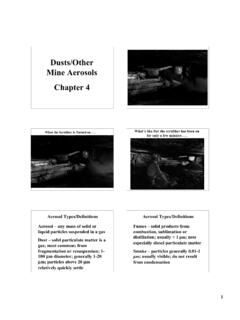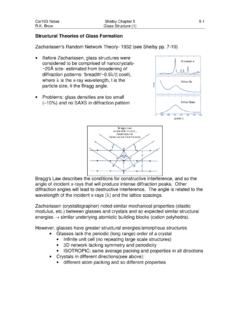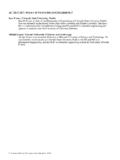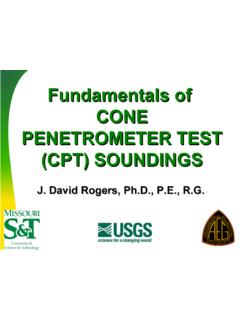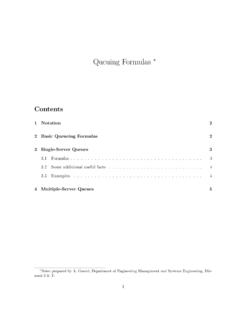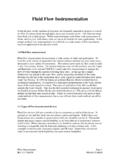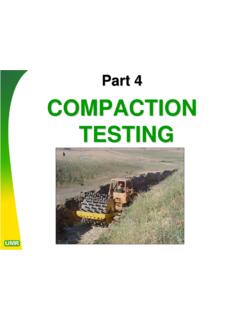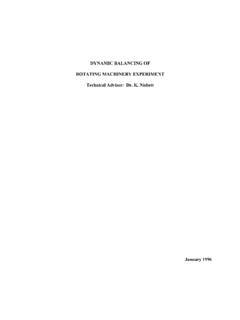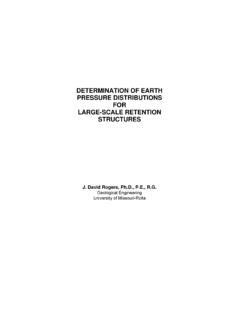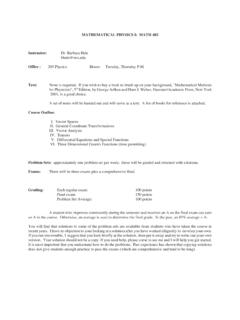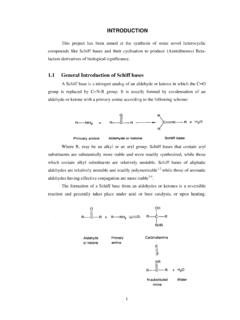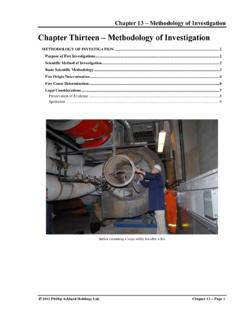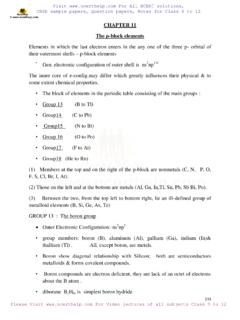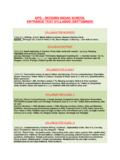Transcription of Immiscibility/Phase Separation: Glass Microstructure
1 Cer103 NotesShelby chapter BrowImmiscibility/Phase SeparationImmiscibility/Phase separation : Glass MicrostructureDifferent liquids have different properties and so, when combined, some will: Form a single, homogeneous mixture miscible Alcohol and water- alcohol is hydrophilic- -OH terminated Not mix, heterogeneous immiscible or phase separated Oil and water- oil is hydrophobicSimilar processes occur in oxide melts: some oxide combinations are miscible,some are of glassy component 'A' dispersed in glassymatrix 'B'.Phase separation occurs in highly viscous samples,'frozen in' on cooling below Tg.
2 (Initial viscosity has tobe low enough for material to re-arrange intoseparate regions).Why do certain compositions exhibit phase separation ? Thermodynamic ExplanationSlide 1:Phase 1 and Phase 2 each have their own 'internal' or free energy (G1, G2, respectively).Total free energy for case A (two separate phases ) is summation of those internalenergies times respective concentrations: GA =X1G1 + Fig. 4-3(Droplet-in-matrixmorphology)Case AComponent 1X1 Component 2X2GA=X1 G1+ X2 G2 Case BGB= GA+ Gmix Gmix= Hm-T Sm (Shelby ) Sm=-R[X1lnX1+ X2lnX2] ( ) Hm= =X1X2 ( ) ===== -ZNA[E1,2-(E1+E2)/2]where E represents bond energiesCer103 NotesShelby chapter BrowImmiscibility/Phase SeparationWhen mixed (case B), total free energy is changed by free energy of mixing( Gm), which depends on the enthalpy of mixing ( Hm, could be exothermic orendothermic) and the entropy of mixing ( Sm).
3 For Regular Solutions: Sm = -R[X1lnX1 + X2lnX2]Entropy is related to system disorder. Upon mixing, systems become moredisordered, Sm always increases, causing Gm to become more negative. Entropy promotes mixing. Hm Em: change in bond energies to make a mixture, must break 1-1 (E1) and 2-2 (E2) bonds to create1-2 (E1,2) bonds. Is the net energy change positive or negative? Hm X1X2 where -ZNAvo[E1,2-(E1+E2)/2] (Z = coordination number) when E1,2>(E1+E2)/2, Hm<0, 1-2 bonds are stronger than 1-1 and 2-2bonds, so the system will prefer to mix.
4 When E1,2<(E1+E2)/2, Hm<0, 1-2 bonds are weaker than 1-1 and 2-2bonds, so the system will avoid mixing- more stable as between entropy and enthalpy determines if Gm < 0 (system will bemiscible); eq. 4-1. (Slide 2) Entropy of mixing always decreases Gm. Enthalpy can either increase or decrease 1: Hm < 0, E1,2 more stable than E1+E2. Complete miscibility (alcohol and water); any combination ofcomponents leads to a reduction in GmFree Energy of Mixing Depends on Enthalpy and Entropy: Gmix= =X1X2 -RT [X1lnX1+ X2lnX2] ( ) Gmix= -ZNA[E1,2-(E1+E2)/2]=X1X2 -RT [X1lnX1+ X2lnX2]CompositionEnergy-T Sm Hm GmExample 1: Hm<0; E1,2>(E1+E2)/2complete miscibilityCer103 NotesShelby chapter BrowImmiscibility/Phase SeparationExample 2: Hm > 0, E1,2 less stable than E1+E2.
5 Enthalpy (positive) and entropy (negative) are competing (Slide 3) At low temperature: small entropy contribution; enthalpy change is most important mixing causes Gm to increase- barrier; phases prefer to beseparate, for most combinations Note that there are certain compositions for which Gm < 0 at T1, the minima are at compositions A1 and B1 at T2, the minima are at compositions A2 and B2a at T3, -T Sm dominates the free energy and Gm<0 for allcombinations (100% miscible).Consolute Temperature (Tc): upper temperature at which separatephases are thermodynamically stable.
6 (Or, lowest temperature atwhich a single phase liquid is thermodynamically stable.)What are the consequences of these free energy minima? Free energy of the system will be reduced if the liquid separates into twophases: with compositions A and B. Common Tangent (tie-line): identifies the lowest energy combinations How much of each phase forms? Lever RuleSlide 4: combinations between compositions A and B have lower Gmix if theyseparate into A and B rather than staying as a single phase <<TcCompositionEnergyT3>TcCompositionT2<TcComposition Hm Gm-T1 Sm Hm Hm Gm Gm-T2 Sm-T3 SmA1B1A2B2 Example 2: Hm>0; E1,2<(E1+E2)/2regions of immiscibility thatdepend on temperature (-T Sm)Cer103 NotesShelby chapter BrowImmiscibility/Phase SeparationNote: compositions not between A and B are miscible: viz.
7 , Gmix is lower as asingle phase mixture than if different phases separated from the mixtureMove to composition 'z'; end up with mixture that has more B-phase. From slide 3, increasing temperature decreases the distance between A' andB' (shorter tie-line) smaller range of immiscible combinations until at T Tcabove which no mixtures are immiscible. These free energy curves 'map out' immiscibility domes in a phasediagram (slide 5).Free energy/composition analysis indicates the thermodynamic underpinnings ofphase separation , but provide no information about kinetics.
8 Similar temperature-dependence on viscosity. If viscosity is low in an immiscibility dome: rapid phase separation If viscosity is high in an immiscibility dome: slow phase separation (can beavoided if melt is quenched fast enough).Composition GmixyAB*P1P2 Composition Y:fraction of phase 1 is[P1]=(P2-Y)/(P2-P1)fraction of phase 2 is[P2]=(Y-P1)/(P2-P1)Lower Gm if comp. Yseparates into A and B:fraction of phase A is[A]=(B-Y)/(B-A)fraction of phase B is[B]=(Y-A)/(B-A)Using the Lever Rule to Determine Compositions*zCompositionTemperatureTcA1 A2B2B1T1T2 Phase Diagrams Are Derived from Free Energy Curves ImmiscibilityImmiscibilityDomeDomeorMisc ibilityMiscibilityGapGapone liquidtwoliquidsCer103 NotesShelby chapter BrowImmiscibility/Phase SeparationMechanisms for Phase Separation: 1.
9 Nucleation and Growth Analogous to nucleation/crystallization distinctly different liquid-in-liquid compositions overcome surface energy barrier must reach critical size to remain stable undercooling provides thermodynamic driving force: (Tc-T)2 material diffusion to interface to form separate droplets high viscosity slow diffusion slow particle growth2. Spinodal Decomposition Compositional fluctuations ( c) reduce Gmix, promote gradual phaseseparation (slide 6). This occurs when d2G/dc2 < 0 (between inflection points C and D) The compositions of the inflection points also vary with temperatureand so map out a second dome where d2G/dc2(T) < 0: Spinodal Dome(See Varshneya (Fig.))
10 4-5, next page) for a diagram that shows shapes of the firstand second derivatives of the free energy curves).Composition Gmix*12*ABCD Range of phase separatedcompositions: A-B Small changes in comp. 1 causean increase in G: distinct,separate phases preferred forranges A-C and D-B, NucleatedPhase separation Small changes in comp. 2 causea decrease in G: Range C-D:phase separation initiated bysmall compositional fluctuations,Spinodal Decomposition(d2G/dc2<0 for C-D)Figure 4-2(Shelby) Gmix(c) at T1T112 ABCDCer103 NotesShelby chapter BrowImmiscibility/Phase SeparationCer103 NotesShelby chapter BrowImmiscibility/Phase SeparationDifferent mechanisms lead to different topologies for phase separated systems: Nucleated: sharp interfaces, invariant (distinct) compositions Spinodal.
